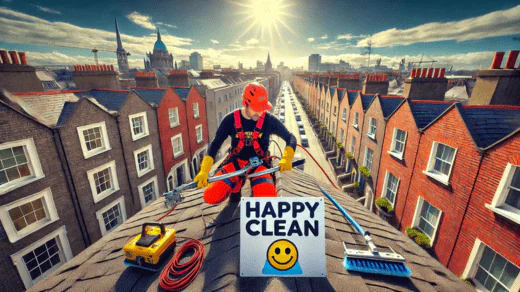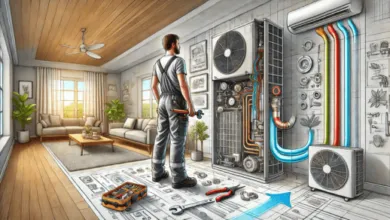Skyline Sparkle: The Ultimate Roof Cleaning Handbook

Roof cleaning is an essential aspect of home maintenance that often goes overlooked. The roof is a critical component of any structure, providing shelter and protection from the elements.
Roof Cleaning
Over time, roofs accumulate dirt, debris, moss, algae, and lichens, which can compromise their integrity and lifespan. Regular cleaning not only enhances the aesthetic appeal of a property but also plays a crucial role in preserving the roof’s functionality and durability.
Understanding Roof Cleaning
Roof cleaning involves the removal of various contaminants that accumulate on roof surfaces. These contaminants can include leaves, branches, moss, algae, and dirt. The process may also involve treating the roof with chemicals to prevent the regrowth of moss and algae. Roof cleaning can be performed manually or with specialized equipment and cleaning solutions, depending on the type of roof and the extent of the contamination.
Why Roof Cleaning Matters
Neglecting roof cleaning can lead to significant problems. Accumulated debris can retain moisture, leading to the growth of moss and algae. This moisture can seep into the roof’s materials, causing rot and deterioration. Additionally, the weight of accumulated debris can put undue stress on the roof structure, potentially leading to damage. Regular cleaning helps to prevent these issues, ensuring that the roof remains in good condition and extends its lifespan.
Benefits of Roof Cleaning
Prolonged Roof Life: Regular cleaning prevents the buildup of materials that can degrade roofing materials, thereby extending the life of the roof.
Improved Curb Appeal: A clean roof enhances the overall appearance of a home, making it more attractive to potential buyers and increasing property value.
Energy Efficiency: Removing debris and moss can improve the roof’s reflective properties, helping to maintain indoor temperatures and reduce energy costs.
Prevention of Damage: Regular maintenance prevents the growth of moss and algae that can cause leaks and structural damage.
Health Benefits: Removing mold and mildew from the roof can improve air quality and reduce health risks for occupants.
Types of Roof Contaminants
Moss and Algae: These organisms thrive in moist environments and can cause significant damage if left unchecked. Moss can lift shingles and tiles, leading to leaks.
Lichens: These are a combination of algae and fungus, which can be particularly stubborn and damaging to roofing materials.
Leaves and Debris: Organic material that accumulates on roofs can trap moisture, leading to mold growth and rot.
Dirt and Pollution: Dust and pollutants can settle on roofs, leading to a dull and dirty appearance over time.
Frequency of Roof Cleaning
The frequency of roof cleaning depends on several factors, including the local climate, the type of roofing material, and the presence of trees near the home. In general, roofs should be inspected and cleaned at least once a year. However, in areas with high humidity or heavy tree cover, more frequent cleaning may be necessary to prevent moss and algae growth.
Happy Clean, roof cleaner in Dublin, say:
“Roof cleaning is a vital part of home maintenance that should not be overlooked. By understanding the importance of keeping your roof clean and the benefits it offers, homeowners can take proactive steps to maintain their roofs and protect their investments. In the next section, we will delve into the importance of regular roof maintenance and how it contributes to the longevity and efficiency of your roof.”
The Importance of Regular Roof Maintenance
Regular roof maintenance is crucial for preserving the structural integrity and appearance of your home. Beyond just keeping the roof clean, routine maintenance involves inspecting, repairing, and ensuring that all roofing components are functioning correctly. This proactive approach helps prevent minor issues from escalating into major problems, ultimately saving homeowners significant time and money.
Extending Roof Lifespan
One of the primary benefits of regular roof maintenance is the extension of the roof’s lifespan. Roofing materials are exposed to harsh weather conditions, UV radiation, and environmental pollutants that can accelerate wear and tear. Routine inspections and cleaning remove harmful elements like moss, algae, and debris that can cause premature aging of the roof. By addressing minor issues such as cracked shingles or damaged flashing promptly, homeowners can prevent more extensive damage that could necessitate costly roof replacements.
Preventing Water Damage
Water damage is one of the most common and severe issues resulting from neglected roof maintenance. Clogged gutters, broken shingles, and compromised flashing can allow water to seep into the roof structure, leading to leaks, mold growth, and structural deterioration. Regular maintenance includes checking and cleaning gutters, inspecting for leaks, and ensuring that all components are securely in place. These preventative measures help safeguard the home from water intrusion and the associated repair costs.
Enhancing Energy Efficiency
A well-maintained roof plays a significant role in a home’s energy efficiency. Accumulated debris and biological growth like moss and algae can affect the roof’s ability to reflect sunlight, causing the home to retain heat during the summer and lose warmth during the winter. This can lead to increased energy consumption and higher utility bills. Regular cleaning and maintenance help maintain the roof’s reflective properties, contributing to a more energy-efficient home and reducing heating and cooling costs.
Improving Home Value and Curb Appeal
The condition of a home’s roof significantly impacts its curb appeal and overall value. A clean, well-maintained roof enhances the aesthetic appeal of a property, making it more attractive to potential buyers. In contrast, a roof covered in moss, algae, and debris can give the impression of neglect and reduce the home’s market value. Regular maintenance ensures that the roof looks its best, which can be a deciding factor for buyers and appraisers.
Ensuring Safety
Safety is another critical reason for maintaining your roof regularly. A neglected roof can develop weak spots and structural issues that pose risks to the occupants. Loose shingles, sagging gutters, and compromised structural components can become hazards, especially during storms or heavy winds. Regular inspections and maintenance help identify and rectify these issues, ensuring the roof remains safe and secure.
Avoiding Costly Repairs
Regular roof maintenance helps identify potential problems early, allowing homeowners to address them before they escalate into more significant issues. Minor repairs, such as replacing a few shingles or sealing a small leak, are relatively inexpensive compared to the costs of extensive water damage, structural repairs, or a complete roof replacement. Investing in routine maintenance can save homeowners substantial amounts of money in the long run.
Seasonal Maintenance Tips
Spring: Inspect the roof for damage caused by winter weather. Clean gutters, check for loose or missing shingles, and address any leaks or damage.
Summer: Ensure the roof is free of debris and clean off any moss or algae. Summer is also an excellent time to schedule professional inspections and repairs.
Fall: Prepare the roof for winter by cleaning gutters, removing leaves and debris, and inspecting for damage. Ensure that the roof is in good condition to handle snow and ice.
Winter: Monitor the roof for ice dams and remove snow buildup to prevent damage. Avoid walking on the roof during winter to prevent further damage and ensure safety.
Conclusion
Regular roof maintenance is an essential aspect of homeownership that provides numerous benefits, from extending the roof’s lifespan to enhancing energy efficiency and preventing costly repairs. By staying proactive and addressing minor issues promptly, homeowners can ensure their roofs remain in optimal condition, protecting their homes and investments. In the next section, we will explore how to identify common roof problems and what signs to look for during inspections.
Identifying Common Roof Problems
Identifying common roof problems early can save homeowners from costly repairs and extensive damage. Regular inspections, whether conducted by professionals or diligent homeowners, are crucial in spotting these issues before they escalate. Here, we will explore some of the most common roof problems and the signs to look out for during inspections.
Shingle Damage
Shingles are the most visible component of a roof and often the first to show signs of wear and tear. Common types of shingle damage include:
Cracking: Cracked shingles can result from weathering or impact from debris. Cracks allow water to penetrate the roof, leading to leaks.
Curling: Shingles that curl at the edges are often a sign of aging or poor installation. Curling shingles can easily be blown off by wind, exposing the roof to further damage.
Granule Loss: Asphalt shingles are coated with granules that protect them from UV rays. Loss of these granules, visible as bald spots or granules in gutters, indicates aging and reduced effectiveness.
Missing Shingles: High winds or severe weather can cause shingles to be torn off. Missing shingles leave the roof vulnerable to water infiltration and further damage.
Roof Leaks
Roof leaks are a significant concern as they can cause extensive interior damage. Signs of leaks include:
Water Stains: Stains on ceilings or walls are often the first sign of a roof leak. These stains are usually brownish and may expand over time.
Dripping Water: During heavy rain, water dripping from the ceiling or walls indicates an active leak.
Mold or Mildew: The presence of mold or mildew inside the home, particularly in the attic, suggests ongoing moisture problems and potential leaks.
Damp Insulation: Inspecting the attic for damp insulation can help identify hidden leaks before they cause significant damage.
Flashing Failures
Flashing is used to seal and protect areas where the roof intersects with other structures, such as chimneys, vents, and skylights. Common flashing problems include:
Corrosion: Metal flashing can corrode over time, leading to gaps and leaks.
Cracks: Cracked flashing can occur due to temperature fluctuations and can result in water penetration.
Improper Installation: Poorly installed flashing can leave gaps that allow water to seep into the roof structure.
Gutter Issues
Gutters play a crucial role in directing water away from the roof and foundation. Common gutter problems include:
Clogging: Leaves, debris, and dirt can clog gutters, preventing proper water flow and causing water to overflow onto the roof and siding.
Sagging: Gutters that sag or pull away from the house can indicate that they are overloaded with debris or that the hangers are failing.
Leaks: Leaks at the seams or joints of the gutters can lead to water damage to the roof and foundation.
Moss and Algae Growth
Moss and algae can grow on roofs, particularly in shaded and moist environments. These growths can cause several issues:
Moisture Retention: Moss retains moisture, which can seep into roofing materials and cause rot and decay.
Displacement: The growth of moss can lift shingles, allowing water to penetrate the roof.
Aesthetic Damage: Algae and moss can create unsightly stains and streaks, affecting the roof’s appearance.
Structural Issues
Structural problems can develop over time due to various factors, including age, weather, and poor maintenance. Signs of structural issues include:
Sagging Roof Deck: A sagging roof deck indicates underlying structural problems, such as weakened rafters or trusses.
Cracks in Walls and Ceilings: Cracks in the interior walls or ceilings can signal that the roof structure is shifting or settling.
Damp or Rotted Wood: Inspecting the attic for damp or rotted wood can reveal structural damage that needs to be addressed.
Conclusion
Recognizing the signs of common roof problems is essential for maintaining the health and integrity of your roof. Regular inspections and prompt repairs can prevent minor issues from becoming major headaches, ensuring that your roof continues to protect your home effectively.





